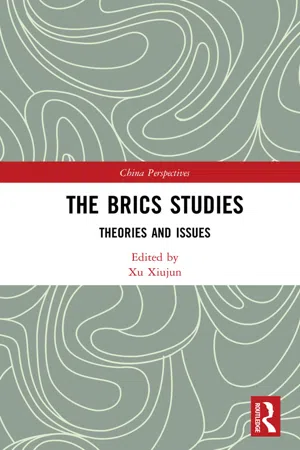
- 280 pages
- English
- ePUB (mobile friendly)
- Available on iOS & Android
About This Book
Given their immense potential for development and representation of a new international political and economic order, the BRICS countries have become a strong nascent force on the global stage. However, as overall economic growth continues to slow down, and the geopolitical situation becomes more complex, the BRICS countries are facing a series of new challenges that require further development in the way they cooperate with one another.
This volume offers a panoramic view of cooperation between the BRICS countries in the light of these new challenges. The editors reveal that policy coordination has been strengthened, bringing into play complementary advantages as viable ways for promoting robust, sustainable, and balanced growth in the world economy. They argue that the experience gained, and lessons learned in the development of and cooperation between the BRICS countries has offered a positive role model for cooperation between other countries as well as providing valuable lessons for research in international politics.
Students and scholars in international relations and politics will benefit from this volume.
Frequently asked questions
Information
1The BRICS studies
Academic approach and frontier issues
1. New trend of BRICS’s development and cooperation
1.1 A continuous rise in economic strength but with differentiated economic growth
| Year | GDP calculated on market-based exchange rates | GDP based on PPP | ||
| Scale ($100 million) | Percentage of global total (%) | Scale ($100 million) | Percentage of global total (%) | |
2000 | 27229 | 8.2 | 91709 | 18.7 |
2005 | 50350 | 10.7 | 145641 | 21.8 |
2010 | 117676 | 18.0 | 238925 | 27.1 |
2015 | 164838 | 22.5 | 349911 | 30.8 |
1.2 New breakthroughs achieved in pragmatic cooperation in spite of growing challenges
| No. | Time | Venue | Main fruits |
1st meeting | June 2009 | Yekaterinburg | Issuing a joint statement and ratifying a joint statement on global food security. |
2nd meeting | April 2010 | Brasilia | Issuing a joint statement on the second formal meeting of BRICS leaders, and holding an entrepreneurs’ forum, a forum of banks and cooperatives and a meeting of think tanks. |
3rd meeting | September 2011 | Sanya | Publishing the Sanya Declaration and signing a framework agreement on financial cooperation among the banks of the BRICS countries. |
4th meeting | April 2012 | New Delhi | Issuing the Delhi Declaration and its Action Plan, signing a general accord on multilateral local-currency credit authorization under the cooperative mechanism of the BRICS banks and an agreement on multilateral letter of credit protection and conversion services, and discussing the possibility of setting up a new development bank. |
5th meeting | March 2013 | Durban | Issuing the Durban Declaration and its Action Plan, publishing a cooperative framework on trade and investment of the BRICS countries, setting up a business council and a think tank council of BRICS countries, and deciding to set up the BRICS new development bank and an emergency reserve mechanism. |
6th meeting | July 2014 | Fortaleza | Issuing the Fortaleza Declaration and its Action Plan, signing the agreements on the establishment of the BRICS new development bank and emergency reserve and signing an accord on bank cooperation among the BRICS countries, and a memorandum of understanding on technical cooperation among export credit and insurance agencies of the BRICS countries. |
7th meeting | July 2015 | Ufa | Issuing the Ufa Declaration, formulating an economic partnership of the BRICS countries, passing an e-commerce cooperation framework, signing an inter-central bank accord on the BRICS emergency reserve arrangement, and holding the first council meeting of the newly established BRICS new development bank. |
8th meeting | October 2016 | Goa | Issuing the Goa Declaration, signing of the Regulations on Customs Cooperation Committee of the BRICS, signing of the MoU for Establishment of the BRICS Agricultural Research Platform, endorsing the Goa Action Plan |
9th meeting | September 2017 | Xiamen | Issuing the Xiamen Declaration, endorsing BRICS Action Agenda on Economic and Trade Cooperation, BRICS Action Plan for Innovation Cooperation (2017–2020), Action Plan 2017–2020 for Agricultural Cooperation of BRICS Countries, and Action Plan for the Implementation of the Agreement between the Governments of the BRICS States on Cooperation in the Field of Culture (2017–2021) |
Table of contents
- Cover
- Half Title
- Series Information
- Title Page
- Copyright Page
- Contents
- Figures
- Tables
- Contributors
- Preface
- Acknowledgements
- 1 The BRICS studies: Academic approach and frontier issues
- 2 Non-neutrality of international regimes and the BRICS cooperation
- 3 Theoretical explanations for the origin of BRICS cooperation
- 4 BRICS cooperation in the game of countries
- 5 International structure and the BRICS cooperation
- 6 Practice theory and China’s participation in BRICS cooperation
- 7 The BRICS countries and global economic governance
- 8 The BRICS countries and the global financial governance
- 9 Construction of free trade zones in the BRICS countries
- 10 The BRICS countries and new international direct investment rules
- 11 The BRICS countries and international energy cooperation
- 12 The BRICS countries and international cooperation on climate change
- 13 The BRICS countries and global cyberspace governance
- 14 The BRICS countries and the construction of New Development Bank
- 15 Cooperation among the BRICS countries for developing emerging industries
- References
- Index